Today’s author guest post by George O’Connor covers a lot of ground in a unique format. We hope you enjoy it as much as we did!
For the record, he really is a favorite of ours! ?
—
The word came down from one of the marketing gurus at my publisher, Macmillan. Mackin, the eminent educational resource company, wanted to know if I would write a guest post for their blog. It would be the first time a graphic novelist such as myself would be featured thusly on their site, and I was a favorite ‘round their offices (or so they claimed). They certainly knew how to hit my buttons. I said yes, of course, I’d be delighted to write a guest post.
Now any creative type worth their salt will tell you there is nothing as terrifying/liberating as a blank page, so I inquired after the fine folks at Mackin as to what they would like to see me write about. They nicely replied with a list of suggested topics that might fit the scope of their blog.
Your writing process
Trends in children’s literature
Connecting with kids/readers (school visits, signings, etc.)
Diversity in literature
Your passion/mission
Okay, I thought, I’ll do all of them. And to boot, let me write this as an interview I conduct with myself, because why not? And I’ll throw in some drawings too, because as a cartoonist I’m all about communicating with pictures in addition to words. Alright, we ready for this? Let’s go.
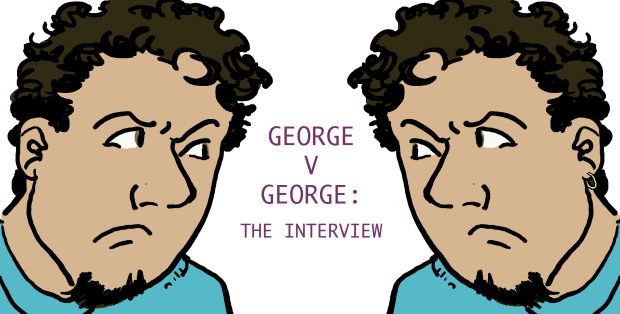 ME: Hi George, please describe your working process.
ME: Hi George, please describe your working process.
MYSELF: Oh man, George, we’ve described this a million times over already. Are we really going to give these people the same warmed over response we always do?
ME: I, uh, what?
MYSELF: I could go on here about every step by step I take, in excruciating technical detail that will probably be only of interest to me, myself and I…
ME: I would find it interesting.
MYSELF: Instead, I’m going to cut to the heart of it. No matter how I arrive at creating my comics, the importance of comics, the thing that makes comics unique among other forms of literature, is the complete symbiosis that the words and pictures share in telling the story. As such, when I’m creating a comic, at every step of the way I’m treating the words and pictures as equals. Every cartoonist has his or her own process, but for me, I’ve learned I can’t write a script and then illustrate it, and I can’t draw a comic then script it. The story emerges, step by step, in pass after pass in an accruement of words and pictures working together. The final project, ideally, is a story with pictures you can read.
ME: Let’s talk about trends in kid’s lit. What trends are you noticing?
MYSELF: Well, from my perspective, comics have really arrived, haven’t they? I hesitate to even call them a trend—to me, a trend bespeaks to something that flows and ebbs, something a bit ephemeral, but I think comics are beyond that now. There is an immediacy to comics, which convey so much of their information instantly through visuals, faster even than the written word. In surprisingly short order, educators and librarians have gotten behind comics, or graphic novels, call them what you will, in a way I never could have predicted. It’s amazing and inspiring, and my career would not even exist if it weren’t for them.
ME: Mine, either.
MYSELF: I think comics are here to stay, not as a genre, but as a medium, another amazing way to tell stories. Of course, I could be wrong, we could all be riding a huge comics bubble and everything I’m talking about will be forgotten in a few years.
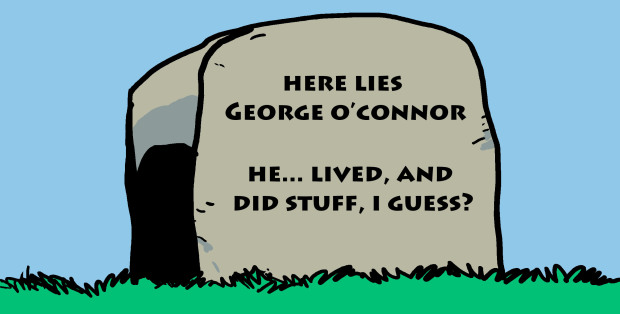 ME: Any thoughts on the connection you feel with your audience, such as at signings, or school events?
ME: Any thoughts on the connection you feel with your audience, such as at signings, or school events?
MYSELF: Personally, I really put a lot of thought and effort into any appearances I may do, be it bookstore, school, library or whathaveyou. I spent many years working in a children’s booksore (Books of Wonder, in NYC) and I saw, firsthand and many times over, the effect a child’s encounter with an author could have. I still remember the first author I met, Patricia Reilly Giff, when I was in fourth grade.
ME: yeah, she was great.
MYSELF: Our society is not structured to make following your dream of being a creative type easy. Speaking as someone who bears the psychic scars of middle school to this day, I know the importance of reaching out to the kids who want to write, to draw, to do whatever, to let them know it’s possible. It won’t be easy, it ultimately may not be what they want to do, but everyone owes it to themselves to at least pursue what makes them happy.
ME: Life, Liberty and the pursuit of happiness. George, tell me, as a straight, white cisgendered male living in the United States—what do you feel about diversity in kid’s literature?
MYSELF: Yowza. Alright, gonna answer this question with an anecdote.
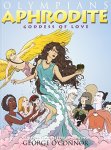 When I do school visits, I have a powerpoint presentation wherein I talk about the various books in my OLYMPIANS series of graphic novels. Whenever the slide comes up for the cover of Aphrodite: Goddess of Love, kids start clapping. Aphrodite is a fascinating character in the Greek pantheon. She’s the outsider—theonly major god who is not a blood relation to Zeus. She married into a crazy dysfunctional family of shape-changing all-powerful lunatics. The ancient Greeks who worshipped viewed her as very exotic, as having come from distant lands to the east. I used this as an opportunity to inject a little color into my depiction of the Olympians. I think it’s very important for all of us, no matter our color, gender or sexuality, to see ourselves reflected in the works of art we create.
When I do school visits, I have a powerpoint presentation wherein I talk about the various books in my OLYMPIANS series of graphic novels. Whenever the slide comes up for the cover of Aphrodite: Goddess of Love, kids start clapping. Aphrodite is a fascinating character in the Greek pantheon. She’s the outsider—theonly major god who is not a blood relation to Zeus. She married into a crazy dysfunctional family of shape-changing all-powerful lunatics. The ancient Greeks who worshipped viewed her as very exotic, as having come from distant lands to the east. I used this as an opportunity to inject a little color into my depiction of the Olympians. I think it’s very important for all of us, no matter our color, gender or sexuality, to see ourselves reflected in the works of art we create.
And if you’re interested, my design for Aphrodite? I combined Sofia Vergara from Modern Family with Beyonce.I don’t think anyone could ever deny that my design of Aphrodite is anything less than the most beautiful creature she is in myth.
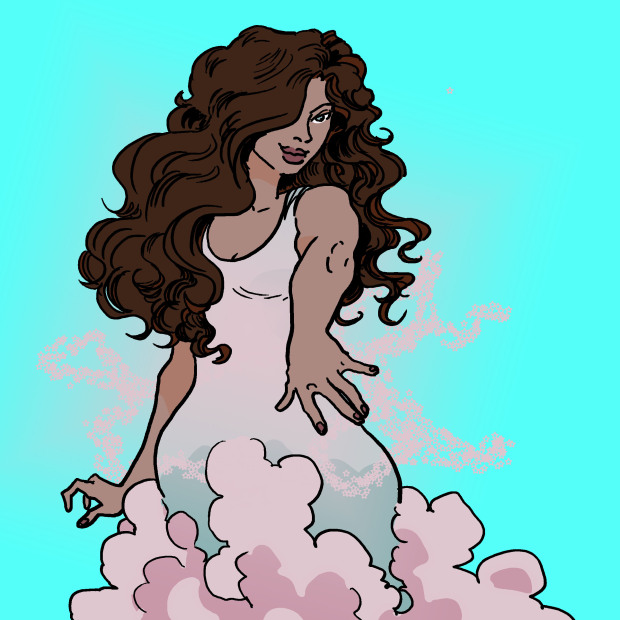 ME: Very nicely said.
ME: Very nicely said.
MYSELF: Thank you.
ME: Couldn’t help but notice you didn’t really answer the question…
MYSELF: Next!
ME: In closing, Mr. O’Connor—what is your passion? What is your mission?
MYSELF: Wow, my passion? My mission? I mean, I’m passionate about many things. I’m passionate about the proper use of the word ‘decimate’. I’m passionate about the little Lego town I’ve made in my house. I’m passionate about getting people to call Heracles Heracles and not Hercules. But I’m not sure any of that stuff qualifies as my mission…
Look, I’m a really fortunate guy. I get to do what I love most in the world, drawing and telling stories, for a living. I get to travel all around the country talking about it. I get to share my love of the Greek myths with the whole world. My mission, I guess, is I’m a cartoonist, and I live my life doing the perfect job for me. At the end of the day, I’m just a humble guy who wants to be remembered for doing what he loved, maybe with a 20 foot monument in a park somewhere. Yeah, that’s my mission.
ME: Sounds good, George. Thank you.
MYSLEF: And thank you, George.
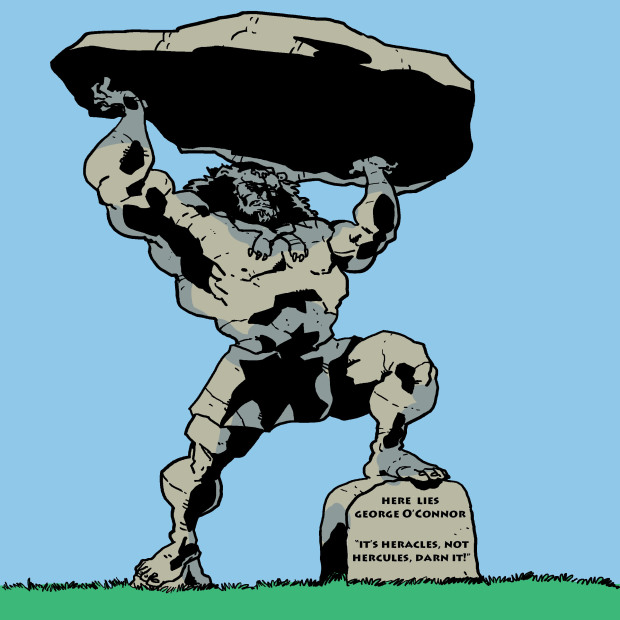
—
From the Publisher
About the Author: George O’Connor is the author of several picture books, including the New York Times bestseller Kapow!, Kersplash, and Sally and the Some-thing. His debut graphic novel, Journey into Mohawk Country, was published by First Second, as was Adam Rapp’s Ball Peen Hammer, which O’Connor illustrated. His series The Olympians includes such titles as Poseidon, Hera, Athena, Hades, and Zeus.
The Olympians series:






